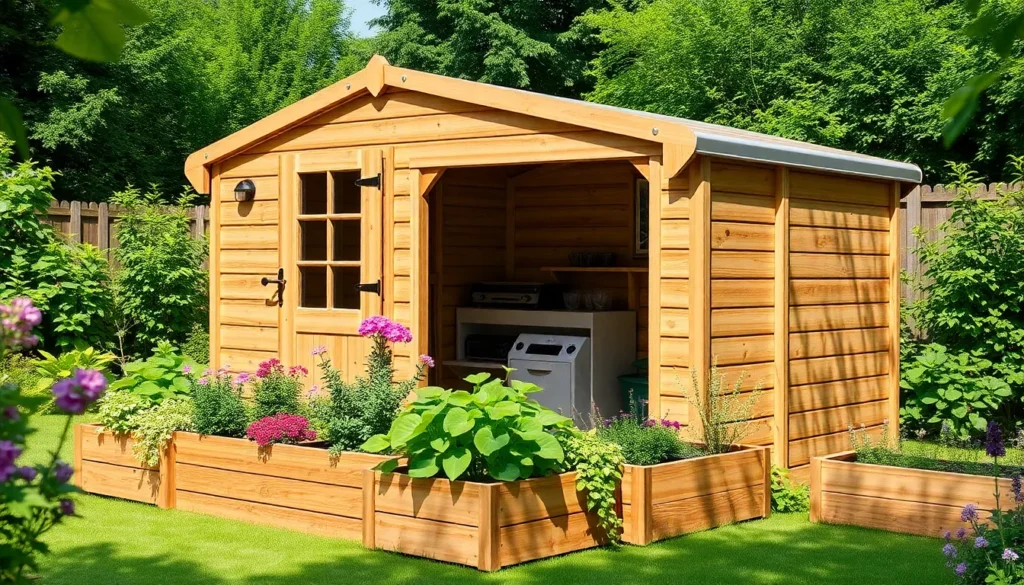In a world where plastic bags seem to multiply like rabbits and climate change feels like an unwanted houseguest, sustainable living has become the superhero we never knew we needed. It’s not just about hugging trees or wearing hemp sandals (though those are cool too); it’s about making everyday choices that lead to a healthier planet and a happier you. Imagine sipping your morning coffee knowing you’ve saved the earth from yet another single-use cup disaster.
Table of Contents
ToggleWhat Is Sustainable Living?
Sustainable living emphasizes making conscious choices to maintain environmental balance. It plays a crucial role in combating issues like climate change, promoting health, and preserving resources.
Definition and Importance
Sustainable living refers to the practice of reducing one’s ecological footprint through mindful consumption and conservation efforts. This approach prioritizes resources that are renewable and biodegradable. Every action, from using reusable bags to conserving water, contributes positively to planetary health. Embracing sustainable living leads to a healthier environment and benefits individual well-being. Individuals experience improved mental and physical health from engaging in sustainable practices.
Key Principles of Sustainability
Sustainability revolves around several key principles that guide behaviors. First, conservation encourages the efficient use of resources to minimize waste. Second, renewable energy advocates a shift from fossil fuels to alternatives like solar and wind power. Third, biodiversity protects ecosystems by maintaining a balance among species. Fourth, social equity ensures that all communities have access to resources and environmental benefits. Fifth, sustainable agriculture promotes practices that protect soil health while maximizing food production. Understanding these principles empowers individuals to make informed choices in their daily lives.
Benefits of Sustainable Living

Sustainable living provides numerous advantages, significantly benefiting both individuals and the environment. Embracing this lifestyle fosters a healthier planet and enhances personal well-being.
Environmental Impact
Sustainable living leads to reduced waste and lower carbon emissions. Choosing reusable products instead of single-use items minimizes plastic pollution significantly. Conserving energy by utilizing renewable sources like solar and wind power protects natural resources. Protecting biodiversity becomes easier through sustainable agricultural practices that restore ecosystems. Sustainable living efforts create cleaner air and water, profoundly impacting overall public health.
Economic Advantages
Sustainable practices can reduce long-term costs for households. Using energy-efficient appliances lowers utility bills, as they consume less energy. Investing in sustainable products often translates to savings over time due to their durability. Supporting local, sustainable businesses stimulates the local economy and fosters job creation. Additionally, adopting eco-friendly habits enhances resource efficiency, ultimately leading to financial savings.
Starting Your Sustainable Living Journey
Embarking on a sustainable living journey involves thoughtful reflection and gradual change. Individuals often start by assessing their current habits and identifying areas for improvement.
Assessing Your Current Lifestyle
Begin by evaluating daily routines, consumption patterns, and waste management practices. Taking inventory of products used regularly helps understand their environmental impact. Consider food choices, transportation methods, and energy consumption. Tracking these factors highlights areas where changes can lead to sustainability. For instance, replacing single-use plastics with reusable alternatives can lower waste significantly. Using apps that calculate carbon footprints might also aid in clarifying personal contributions to environmental issues. Recognizing these patterns lays the foundation for meaningful shifts towards sustainability.
Setting Realistic Goals
Next, focus on establishing achievable sustainability goals. Start with small, manageable changes that can build momentum over time. Committing to buy local produce or reducing meat consumption can significantly reduce one’s environmental footprint. Setting a goal to implement one new habit each month encourages gradual progress. Prioritizing goals helps maintain focus and fosters a sense of accomplishment. As goals become routines, reassessing and adapting them ensures continued growth. The journey towards sustainable living thrives on consistent, realistic changes that align with individual lifestyles and values.
Practical Tips for Sustainable Living
Sustainable living encompasses various everyday practices that individuals can implement easily. These changes not only benefit the planet but also enhance personal quality of life.
Energy Conservation
Energy conservation plays a critical role in sustainable living. Utilizing energy-efficient appliances reduces electricity consumption significantly. Switching to LED bulbs diminishes energy use while providing brighter light. Incorporating smart thermostats helps manage heating and cooling effectively. Additionally, unplugging devices when not in use limits unnecessary energy drain. Investing in renewable energy sources, such as solar panels, increases self-sufficiency. Each of these steps contributes to lowering carbon emissions, creating a healthier environment.
Waste Reduction
Waste reduction strategies are vital to decreasing environmental impact. Opting for reusable bags during shopping minimizes the reliance on single-use plastic. Choosing products with minimal packaging supports a circular economy. Establishing a compost bin for organic waste enriches soil while diverting materials from landfills. Documenting waste generation can reveal insights on areas to improve. Collaborating with local recycling programs ensures proper disposal and reuse of materials. Each effort in waste reduction leads to a cleaner, more sustainable community.
Sustainable Food Choices
Sustainable food choices significantly impact ecological health. Prioritizing locally sourced produce reduces transportation emissions, supporting local economies. Incorporating more plant-based meals lowers the demand for meat, which consumes considerable resources. Organic farming methods contribute to biodiversity and healthier soil. Meal planning prevents over-purchasing and minimizes food waste at home. Participating in a community garden fosters connections while offering fresh produce. Each mindful choice within the food system promotes a more sustainable lifestyle.
Creating a Sustainable Home
Creating a sustainable home involves incorporating practices and products that minimize environmental impact while enhancing quality of life.
Eco-Friendly Products
Eco-friendly products reduce toxic waste and support sustainable practices. Reusable items, such as cloth shopping bags and stainless steel water bottles, replace single-use plastics effectively. Selecting products with minimal packaging or made from recycled materials decreases waste significantly. Natural cleaning supplies, like vinegar and baking soda, clean homes without harmful chemicals. Opting for furniture crafted from sustainable wood ensures less deforestation. Energy-efficient appliances also play a crucial role, as they consume less energy and lower utility bills. Investing in these products not only supports eco-friendly living, but also promotes health and wellness at home.
Water Conservation Techniques
Water conservation techniques help preserve this vital resource. Installing low-flow showerheads and faucets reduces water consumption without sacrificing comfort. Collecting rainwater in barrels provides a sustainable source for outdoor watering. Utilizing mulch in gardens retains soil moisture, minimizing irrigation needs. Implementing smart irrigation systems ensures water is used only when necessary. Fixing leaks promptly prevents significant water waste over time. Educating family members about mindful water use fosters a culture of conservation. Adopting these techniques contributes to a more sustainable home while lowering water bills.
Community and Sustainable Living
Community plays a vital role in advancing sustainable living. Individuals can enhance their eco-friendly habits while connecting with others who share similar values.
Engaging with Local Initiatives
Participating in community clean-up events fosters environmental awareness and strengthens local bonds. Joining a local farmers market not only supports sustainable agriculture but also promotes the consumption of fresh, organic produce. Community gardens create opportunities for neighbors to collaborate, share resources, and learn from each other’s gardening experiences. Volunteering for environmental non-profits allows individuals to contribute directly to conservation efforts, ensuring a cleaner environment. By engaging with these local initiatives, individuals can collectively make a more significant impact while enjoying the benefits of teamwork and shared goals.
Building a Supportive Network
Forming connections with like-minded individuals encourages accountability in sustainable practices. Friends can motivate each other to adopt eco-friendly habits, such as carpooling or sharing sustainable product recommendations. Joining online forums allows enthusiasts to exchange tips and resources for reducing waste and conserving energy. Local sustainability groups often host workshops, enabling community members to learn effective strategies for living sustainably. Creating a supportive network reinforces motivation, as individuals share successes and challenges on their sustainability journeys.
Embracing sustainable living isn’t just a trend; it’s a necessary shift towards a healthier planet. Each small action contributes to a larger movement that benefits both individuals and the environment. By making conscious choices and setting achievable goals, anyone can embark on a sustainable journey that aligns with their values.
The collective effort of individuals can lead to significant change, fostering a sense of community and shared responsibility. As more people adopt eco-friendly habits, the positive impact on public health and local economies becomes evident. Sustainable living is a pathway to a brighter future, one that prioritizes the well-being of the planet and its inhabitants.










